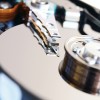As it is, your computer's hard drive is dependent on
strong magnets to spin up and perform a variety of functions. As technology evolves, scientists are continually looking for ways to enhance the efficiency of these devices. Recent studies have suggested that magnetic material could
revolutionize hard drives in the future.
Unique Properties
According to Science magazine, a team of researchers at the University of California, San Diego, discovered a nanomaterial which is so heat-sensitive that the slightest rise or fall in temperature can
drastically impact the magnetism of a metal bilayer. The material is an ultra-thin layer of nickel and a slightly thicker layer of vanadium oxide.
Scientists then had to cool the mixture to -153 degrees Celsius and impose a strong magnetic field to measure the material's coercivity. They found that when temperature changes between -88 degrees Celsius and -108 degrees Celsius, the coercivity surged up to five times. This made the nanomaterial highly resistant to flipping its magnetic orientation. The coercivity then dropped when the scientists lowered the temperature to 123 degrees.
This ability to dramatically switch its magnetic orientation is highly unusual. Science magazine noted that traditional magnets aren't usually as responsive to subtle temperature changes. For example, the news source explained that a typical
bar magnet has high coercivity, meaning its internal grains are extremely resistant to aligning, which is why it maintains north and south magnetic poles. On the other hand, nickel, iron and other materials have low coercivity, so they can flip their orientations more readily.
Coercivity is typically dependent on both the magnet's composition as well as the temperature. That's why this new nanomaterial is so intriguing: It defies what we know about coercivity.
Exciting Implications
Why is this significant? It's a valuable property in electronic engineering, and could eventually result in the creation of new kinds of computer memory. Business Standard reported that Ivan Schuller, who led the studies, claimed that there is
no other known material that is capable of this. It is a metal when the oxide is in high temperatures, but it is an insulator in low temperatures. In between, however, it becomes a different material entirely.
The researchers revealed their findings, published in Applied Physics Letters, at the recent American Physical Society meeting in Colorado. "This is what we physicists like to do - look at things that are huge effects, that are fantastic effects," said Schuller, as quoted by Science magazine.
Schuller seems optimistic about the possibility of temperature-controlled computer memory in the future. This could mark a major improvement from the current heat-assisted devices.
Discover More With Apex Magnets
Want to stay up-to-date on the latest magnetic discoveries? Sign up for our newsletter to get these stories and more sent straight to your inbox each month. 
